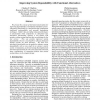Free Online Productivity Tools
i2Speak
i2Symbol
i2OCR
iTex2Img
iWeb2Print
iWeb2Shot
i2Type
iPdf2Split
iPdf2Merge
i2Bopomofo
i2Arabic
i2Style
i2Image
i2PDF
iLatex2Rtf
Sci2ools
DSN
2004
IEEE
2004
IEEE
Improving System Dependability with Functional Alternatives
We present the concept of alternative functionality for improving dependability in distributed embedded systems. Alternative functionality is a mechanism that complements traditional performability and graceful degradation techniques. Rather than providing reduced performance or functionality when components or subsystems fail, alternative functionality replaces a lost feature with another existing system function that can substitute for the lost service. This can provide improved system dependability when it is not feasible to allocate dedicated backup systems for fault tolerance. We show how alternative functionality can be applied to enhance system dependability with a case study of an elevator control system. In simulation, an elevator design that implemented alternative functionality in some of its subsystems tolerated many combinations of component failures that caused system failures in the original design.
Alternative Functionality | Computer Networks | Dependability | DSN 2004 | Graceful Degradation Techniques |
| Added | 20 Aug 2010 |
| Updated | 20 Aug 2010 |
| Type | Conference |
| Year | 2004 |
| Where | DSN |
| Authors | Charles P. Shelton, Philip Koopman |
Comments (0)

